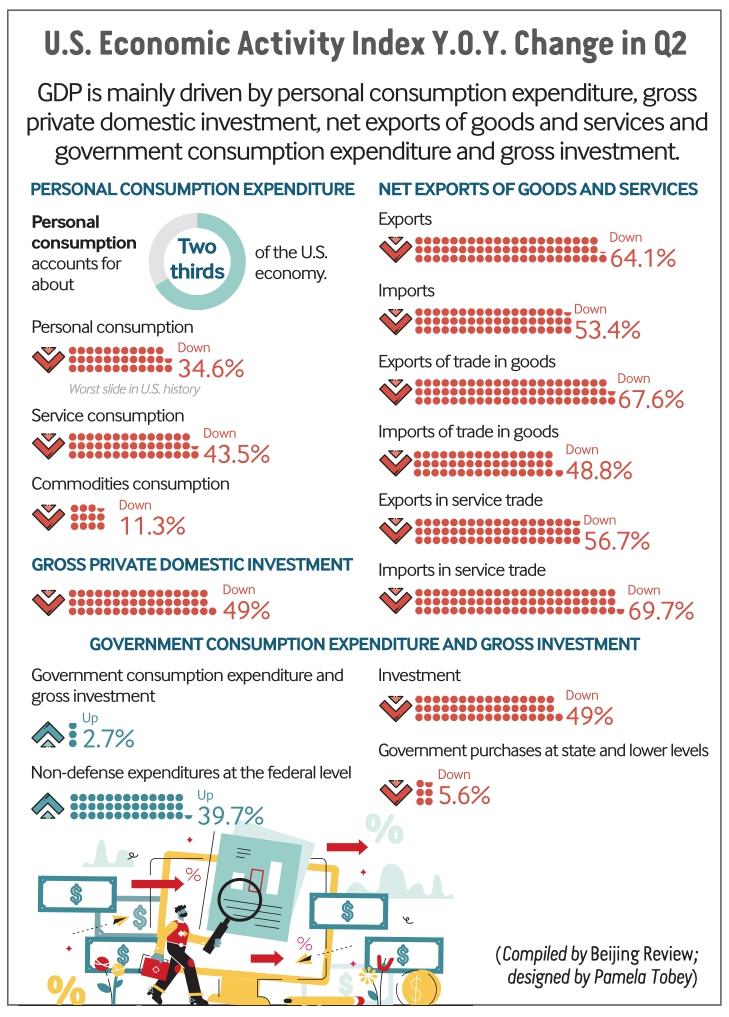Curve of Decline
By Zhou Mi


The U.S. GDP shrank at an unprecedented 32.9-percent annual rate in the second quarter (Q2) of 2020, according to the advance estimate released by the U.S. Bureau of Economic Analysis (BEA) on July 30.
In the fi rst quarter (Q1), the U.S. economy decreased 4.8 percent year on year, ending its 11-year expansion, the longest on record. The accelerated downturn in Q2 made it the worst ever since 1947, when BEA began to release the data.
Prime factors
The U.S. GDP is mainly driven by personal consumption expenditure, gross private domestic investment, net exports of goods and services, and government consumption expenditure and gross investment.Personal consumption has been the most important engine of growth in recent years, accounting for about two thirds of the economy. In Q2, it declined 34.6 percent, the worst slide in history.
The degree of contraction differed greatly from commodities to service consumption. Service consumption plummeted an unprecedented 43.5 percent. With the economy weakening, the unemployment rate picked up quickly while income declined and became more unstable. Consumers with limited savings were forced to slash non-essential spending.
The curtailment was also partly due to the shutdown measures and telecommuting adopted by large companies during the novel coronavirus disease (COVID-19) pandemic, which greatly reduced the flow of people, business trips, transportation, catering and accommodation, as well as personal leisure and entertainment needs.
Commodities consumption dropped 11.3 percent, slightly better than the 11.6-percent slide in the fourth quarter (Q4) of 2008, when the global financial crisis raged. This decrease was mainly led by the dive in consumption of non-durable goods expected to be consumed or used in three years or less, such as food and clothing. However, consumption of durable goods, such as furniture, machinery, property and expensive items with a longer shelf life, decreased only 1.4 percent, which was a major rebound from Q1.
The investment plunge in Q2 was almost serious as that in Q1 of 1975. From 1973 to 1975, the most severe economic crisis since World War II prevailed. Investment plummeted as many countries were affected and many enterprises went bankrupt. Investment refl ects enterprises and other private investors confidence in the economy, and mostly comes through new projects and capital increase to existing ones.
The sharp drop in investment reflected investors poor expectations of the U.S. economic demand. This will greatly impact not only employment, but also the parties in the social supply chains. For example, inventories of raw materials such as steel and iron, and production of consumption goods such as cars, may not improve or even maintain the current level.
Both the export and import volume shrank heavily. In todays globalization era, global trade plays an increasingly important role in economic development. But both U.S. commodity and service trade hit a record low in Q2 due to the decline of domestic production capacity and demand, as well as the high tariff policy adopted by the U.S. Government. The policy distorted the supply-demand relationship and affected economic cooperation between the U.S. and other countries.
In a bid to stabilize the economy, the U.S. Federal Reserve (Fed) injected over $3 trillion of capital into the market and reduced its benchmark federal funds rate to 0-0.25 percent, hoping to save enterprises from bankruptcy and decrease the unemployment rate by providing consumers with cash through transfer payments.
Among the four pillars of the U.S. economy, government consumption expenditure and gross investment was the only one with growth. However, though it increased by a 2.7-percent annual rate, it was far below the 5 percent in Q2 of 2019 due to the effects of the downturn on the state economies. Non-defense expenditures at the federal level increased 39.7 percent, but government purchases at the state and lower levels decreased 5.6 percent year on year.
The last time there had been similar increases in government purchase spending at the federal level was in Q1 of 1967, during the Viet Nam War.
Fast recovery as before?
Normally, BEA releases three rounds of data on economic performance to adjust its estimates based on more complete statistics from multiple channels. The second advance estimate will be released on August 27.There are varied calculations on the U.S. economic performance in the third and fourth quarters. Historically, the external impact on the U.S. economy mostly calmed down soon.
For example, the economy in Q4 of 1957 contracted 4.1 percent, and continued to decline in Q1 of 1958 by 10 percent. However, it started to recover with a growth rate of 2.7 percent in Q2 and continued the trend at 9.6 percent and 9.7 percent in the following quarters.
Another example is the performance after the global fi nancial crisis in 2008. The GDP declined 8.4 percent in Q4 of 2008, and 4.4 and 0.6 percent in Q1 and Q2 of 2009 respectively. But after that it maintained growth for six successive quarters.
If the same trend recurs, the downtrend would rebound quickly. However, todays economic environment is significantly different from that in 2008 and 2009. First, before the economic slump in Q2, there was no evident imbalance between supply and demand. So the contraction was not the kind of the drastic adjustments in history that helped release the pressure and fi nd new balance.
Second, the whole world has been deeply affected by the pandemic, which means the U.S. cannot recover rapidly simply by shifting risks to other countries like it did in 2008.
Notably, the decline in investment in Q2 is greater than in consumption, which may have a significant impact on supply and demand. The slump in consumption warned investors to reduce spending, which in turn would curb the recovery of consumption as a cycle is required for investment to generate benefi ts.
Under the division of labor system in the era of globalization, the U.S. domestic consumption is closely related to the international market. When the domestic supply is insuffi cient, it has to increase imports to meet the demand. If the high tariff policy remains, consumers would inevitably have to pay more for imported commodities, which would increase the diffi culty in meeting consumption demand.
The Fed injected a huge amount of liquidity into the market, focusing on supporting consumers and small businesses. But the money to improve infrastructure for economic development and to help state governments overcome difficulties is inadequate. The cash subsidy for taxpayers expired on July 31 and the new round of fi nancial assistance has been delayed and is expected to shrink signifi cantly. The purchasing power and willingness may not recover signifi -cantly soon.
Against the pandemic background, the relationship between production and service will be totally different. The restructuring of the global supply chains will redistribute benefi ts and might trigger revisions of international trade and economic rules. Trying to respond to the crisis by expanding the overdraft of future resources and adopting more radical protectionist measures would not only damage the international status of the American dollar and U.S. debts, but also undermine international investors perception of the U.S. investment environment.
While investors enjoy low interest rate financing in the U.S., they will reduce their preference for long-term projects that require stable and continuous investment, which will have a greater negative impact on the real economy.

